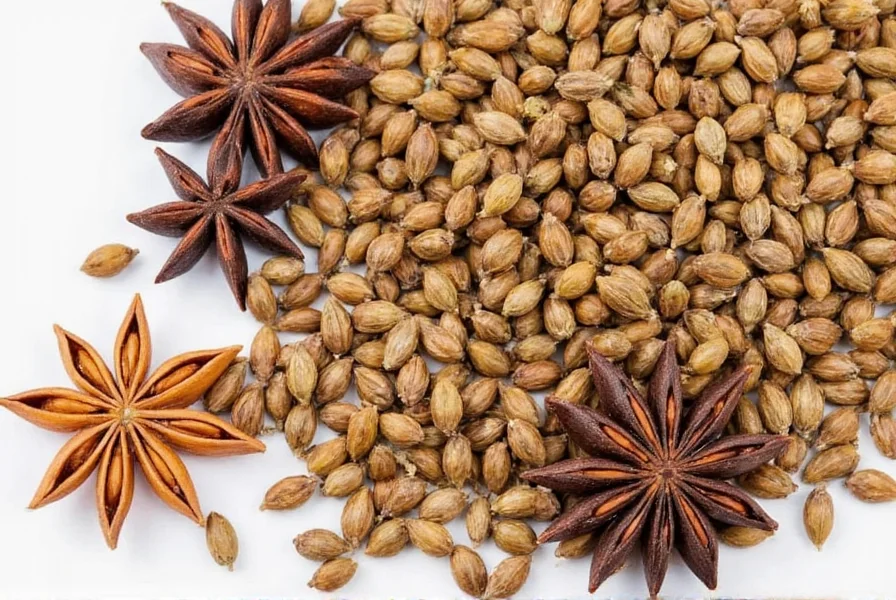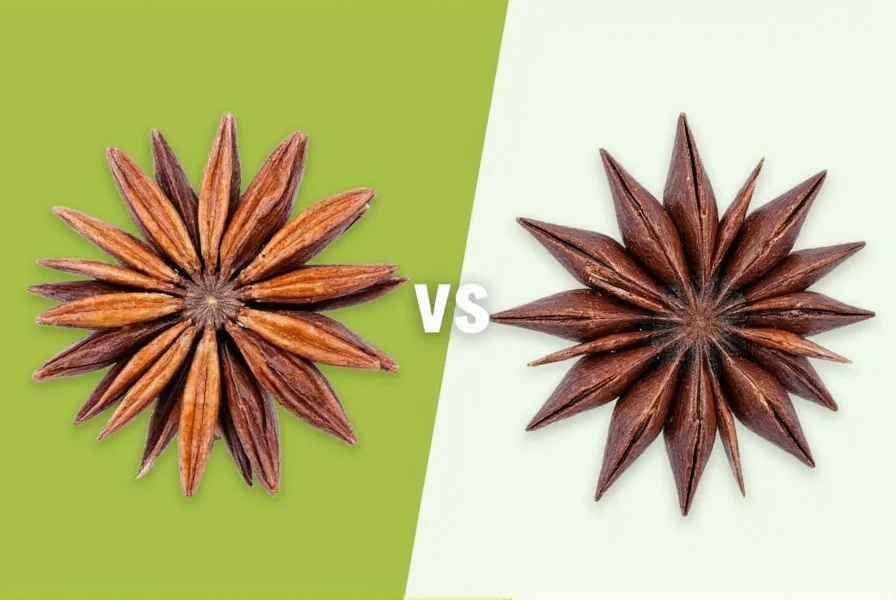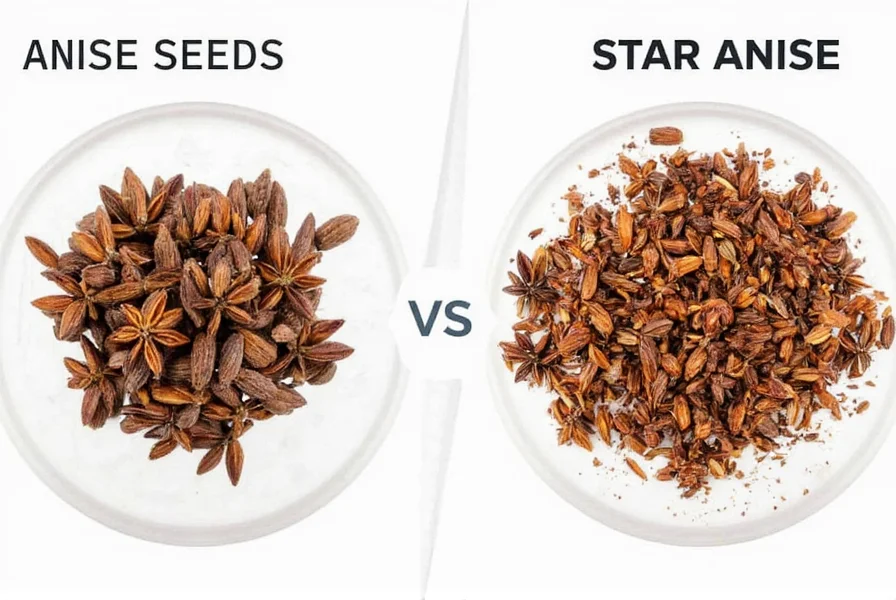Understanding the difference between anise seeds and star anise is essential for home cooks and professional chefs alike. Despite their similar licorice-like flavors and confusingly related names, these spices come from completely different plants and serve unique purposes in global cuisines. Getting them right can make the difference between an authentic dish and a culinary misstep.
Botanical Origins and Plant Families
Anise seeds, also known as aniseed, come from Pimpinella anisum, an annual herb in the Apiaceae family (which includes carrots, celery, and parsley). Native to the eastern Mediterranean and Southwest Asia, this flowering plant produces the small, crescent-shaped seeds we use as spice.
Star anise, by contrast, comes from Illicium verum, a medium-sized evergreen tree in the Schisandraceae family. Native to西南 China and Vietnam, this tree produces distinctive star-shaped fruit pods—typically with eight points—that contain the seeds used as spice. The star-shaped pods give this spice its name.

Physical Characteristics Comparison
The visual differences between these spices couldn't be more distinct:
| Characteristic | Anise Seeds | Star Anise |
|---|---|---|
| Shape | Small, oval, curved seeds (3-4mm) | Star-shaped pods (2.5-4cm diameter) |
| Color | Grayish-brown | Reddish-brown |
| Texture | Smooth, slightly ridged surface | Hard, woody pods with seeds inside |
| Flavor Intensity | Milder, sweeter licorice note | Stronger, more pungent licorice flavor |
| Primary Compound | Anethole (80-90%) | Anethole (80-95%) |
Flavor Profiles and Chemical Composition
Both spices share anethole as their primary flavor compound, which creates that characteristic licorice taste. However, the concentration and additional compounds create notable differences.
Anise seeds offer a sweeter, milder licorice flavor with subtle floral notes. They're often described as having a more delicate, rounded sweetness that works well in baked goods and delicate sauces.
Star anise delivers a more intense, sharper licorice flavor with hints of bitterness and spice. Its flavor is more complex, with subtle notes of cloves and pepper. This intensity makes it ideal for long-cooked dishes where its robust flavor can mellow and integrate.
Culinary Applications Around the World
The difference between anise and star anise becomes most apparent when examining their traditional culinary uses:
Anise seeds feature prominently in:
- Mediterranean baking (biscotti, Greek breads)
- Middle Eastern spice blends like baharat
- French pastis and Greek ouzo liqueurs
- German and Scandinavian baked goods
- Some Indian spice mixes (though less common than in Western cuisines)
Star anise is essential in:
- Chinese five-spice powder
- Vietnamese pho broth
- Indian garam masala and biryani recipes
- Malaysian and Indonesian curries
- Certain Mexican mole sauces
Substitution Guidelines: Can You Swap Them?
Many home cooks wonder if they can substitute star anise for anise seeds or vice versa. The answer depends on the recipe and desired outcome.
When substituting star anise for anise seeds:
- Use 1 whole star anise pod to replace 1 teaspoon of anise seeds
- Remove the whole pod before serving (it's too hard to eat)
- Best for liquid-based recipes like soups, stews, and braises
- Not ideal for baked goods where seed texture matters
When substituting anise seeds for star anise:
- Use 1.5 teaspoons of anise seeds to replace 1 star anise pod
- Grind seeds for more even flavor distribution
- Works better in dry spice rubs than liquid dishes
- May lack the depth of flavor in traditional Asian recipes

Storage Recommendations for Maximum Freshness
Proper storage preserves the volatile oils that give these spices their distinctive flavors:
Anise seeds maintain peak flavor for 2-3 years when stored in an airtight container away from light and heat. Their small size makes them particularly vulnerable to moisture and oxidation.
Star anise pods retain quality longer—up to 4 years—thanks to their protective woody structure. Store whole pods rather than ground star anise for best results, as grinding accelerates flavor loss.
Common Misconceptions Clarified
Several persistent myths surround these spices:
Myth: Star anise is just the flower of the anise plant
Reality: They come from completely unrelated plant species in different botanical families.
Myth: Japanese star anise is the same as Chinese star anise
Reality: Japanese star anise (Illicium anisatum) is toxic and should never be consumed. Always ensure you're using Illicium verum.
Myth: They can be used interchangeably in all recipes
Reality: While substitution is possible in some cases, authentic regional dishes often require the specific spice for proper flavor profile.
Medicinal Uses and Safety Considerations
Both spices have traditional medicinal applications, though scientific evidence varies:
Anise seeds have been used to soothe digestive issues and as a mild expectorant. Some studies suggest potential estrogenic effects, so those with hormone-sensitive conditions should consult healthcare providers.
Star anise is a primary source of shikimic acid, used in producing the antiviral medication oseltamivir (Tamiflu). However, consuming star anise for medicinal purposes requires caution due to potential adulteration with toxic Japanese star anise.
Always purchase from reputable spice merchants to avoid contamination risks, especially with star anise.











 浙公网安备
33010002000092号
浙公网安备
33010002000092号 浙B2-20120091-4
浙B2-20120091-4